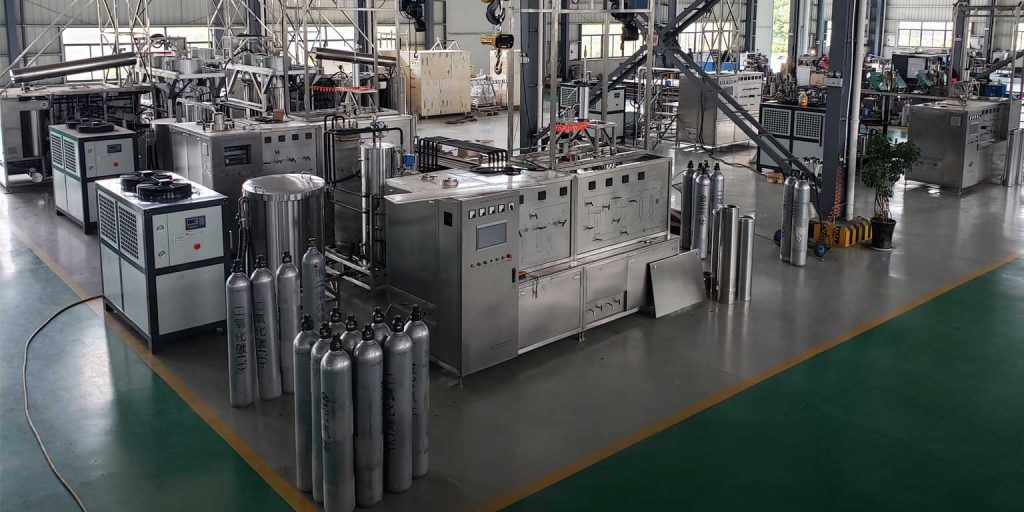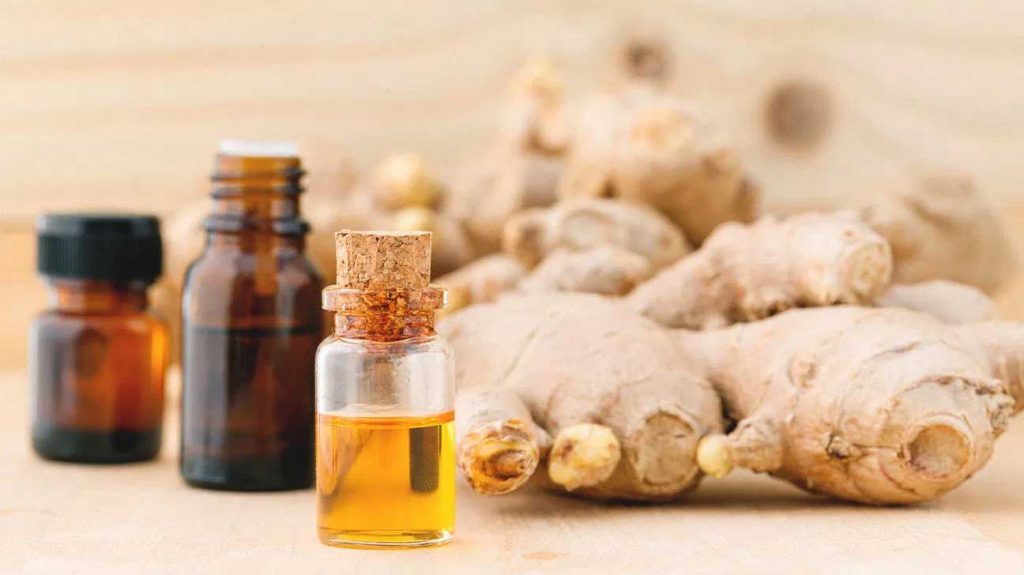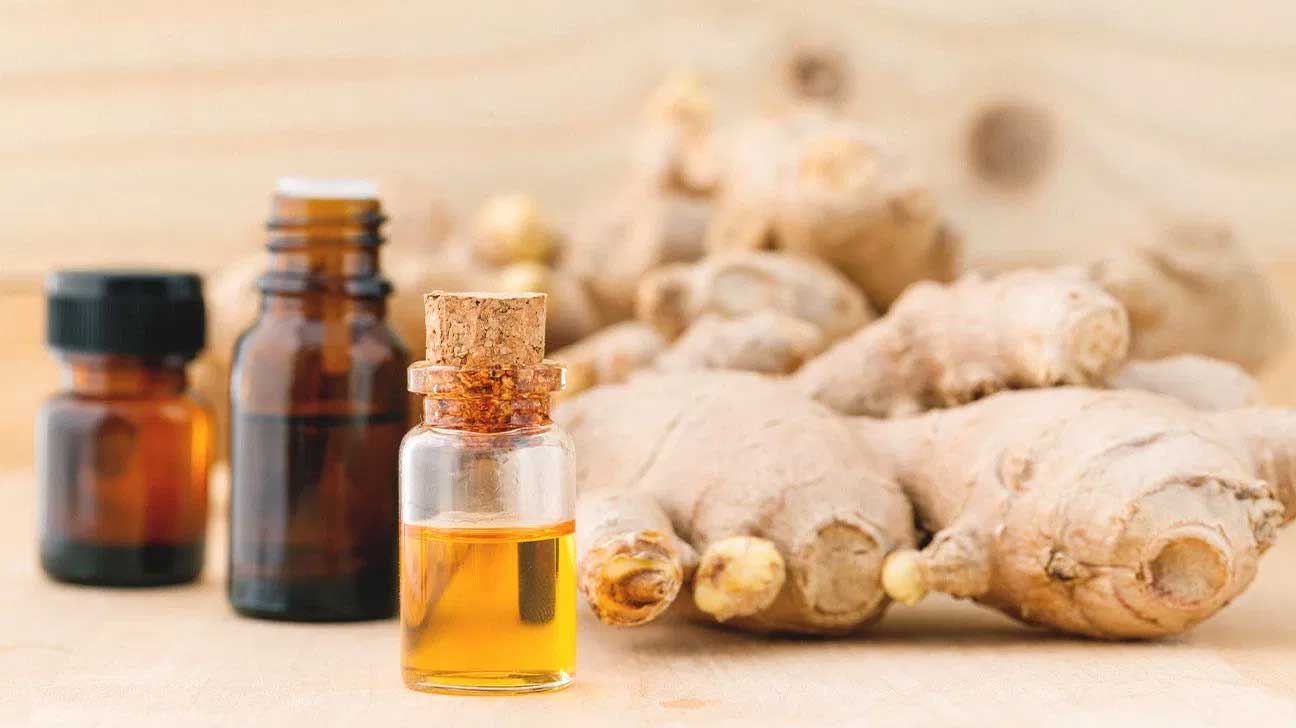Extraction of ginger essential oil by steam distillation
Reagent
Distilled water.
Equipment
Oven, pulverizer, 840gm sieve, stainless steel steamer, condensing device, oil-water separator, etc.
Method of extraction
Raw material → pretreatment → distillation → cooling → oil-water separation → ginger oil.
Extraction process
- Raw materials, select fresh ginger without insects, mildew, and buds as raw materials
- Pretreatment, wash off the sediment with water, remove the roots, and cut into 4-5m thick slices of ginger with a knife, at 60
- Bake ginger slices at a temperature of 65 ℃ for 6-8 hours, so that the water content of fresh ginger slices is reduced to less than 12%. Fresh ginger slices can also be placed on a bamboo curtain for 5-6 days. Generally, every 100kg of fresh ginger slices can be made into 12.5kg of dried ginger slices. When drying, the temperature should not be too high, and the ginger slices should not be too dry, otherwise, part of the ginger oil will be volatilized and the benefit will be reduced. Use a pulverizer to pulverize the dried ginger slices into the size of rice grains, and pass them through an 840 μm sieve. The ginger grains should not be too thick, which will affect the oil production; they should not be too fine, and the water vapor is not easy to pass through.
- Distillation and cooling. Prepare a stainless steel steamer, put a grate in the steamer, lay a layer of gauze on the grate, and spread the ginger grains loosely on the gauze. A certain space should be reserved between the surface of the ginger grains and the upper operator to facilitate the passage of water vapor. After installing the diamond grains, connect the steel distillation tube to the cooler, and pass steam under the steamer to keep the steam pressure at 0.12~0.13MPa. When the steam passes through the ginger granules, the ginger oil in the ginger granules is vaporized due to the high temperature of the steam and enters the cooler with the steam from the distillation tube, and the steam and the vaporized ginger oil are cooled in the cooler into an oil-water mixture.
- Separation of oil and water. Use an oil-water separator to collect the oil-water mixture at the outlet of the cooler, and after standing, the oil-water mixture is separated, the upper layer is ginger oil, and the lower layer is water. Use the separator to remove the water in the lower layer to obtain the ginger oil product.
CO2 Extraction Process of Ginger Essential Oil
Reagent
CO2.
Equipment
250μm sieve, oven, supercritical CO2 extraction machine, etc.

CO2 extraction method
Raw material → pretreatment → supercritical CO2 extraction → ginger oil.
CO2 extraction process
- Raw materials. Choose commercially available fresh ginger that is free of insects, rot, and mildew.
- Pretreatment. Clean the fresh ginger, remove the sediment impurities, dry the fresh ginger slices until the water content is less than 15%, crush the ginger slices into ginger powder and pass them through a 250 μm sieve for later use.
- supercritical CO2 extraction. The best extraction process: when the extraction pressure is 24.0Mpa, the extraction temperature is 50℃, and the CO2 flow rate is 20m3/h, the extraction is performed for 2 hours. The yield of the obtained ginger net oil is about 2.74%.
Steam extraction vs CO2 extraction
The ginger essential oil obtained by steam distillation is a transparent, light yellow to orange flowable liquid.
The physical parameters of ginger essential oil obtained by steam distillation of ginger with different storage periods are roughly the same. However, some compounds in ginger essential oil components are unstable.
Therefore, prolonged exposure of ginger essential oil to light and air will increase the viscosity and form non-volatile polymers, resulting in a decrease in optical rotation. When the temperature exceeds 90 ℃, the composition, smell, and flavor of ginger essential oil will change harmfully.
The appearance of ginger oil obtained by supercritical CO2 extraction is a brownish to brown oily liquid, the refractive index (20°C) is 1.495-1.499, the density (25°C) is 0.86-0.91g/cm3, and the optical rotation is -282-47°.
Application of ginger essential oil
Ginger essential oil is rich in aroma, spicy but not spicy, warm in taste, and has certain aroma characteristics of flowers, which can be widely used in the fields of cosmetics, food and medicine.
For the food field, it is a very good food flavoring agent, and it can be used for flavoring or flavoring ginger essential oil in some non-drunk beverages and dessert wines. It has a long history of medicinal use. It can dispel cold and dampness, expel wind and relieve pain, warm meridians, and dredging collaterals, prevent and treat motion sickness, seasickness, and plane sickness, and has certain anti-aging effects.
Studies have also shown that the terpene compounds in ginger essential oil have protective gastric mucosa and anti-ulcer effects. The ginger essential oil has a certain regulatory effect on the central nervous system, and also has a good anti-inflammatory effect. Therefore, the ginger essential oil has high medicinal value.
Ginger oil is very popular in domestic and foreign markets. Processing high-quality ginger oil has low cost, significant benefits, and broad market prospects.

How to use ginger oil
It’s important to remember that essential oils should never be consumed or ingested.
Continue reading to learn how to use ginger oil safely and effectively for both aromatherapy and topical applications.
Aromatherapy
There are several ways that you can inhale ginger oil for aromatherapy. You can choose which one is right for you:
Diffuser
Diffusers are a great way to add a pleasing scent to a room. In some cases, the essential oil may need to be diluted in water. Always be sure to carefully follow the instructions that come with your diffuser.
Steam inhalation
To use ginger oil for steam inhalation, follow the steps below:
Heat water until it’s steaming and place it in a bowl.
Add a few drops of ginger oil to the steaming water. The University of Minnesota Center for Spirituality and Healing (CSH) recommends only starting with one to two drops.
Drape a towel over your head.
Keeping your eyes closed, place your head over the steaming bowl and inhale deeply.
Sprays
Ginger oil in a spray can be used to freshen the air in a room. To make a spray of ginger oil, you can do the following:
Add ginger oil to water. The National Association for Holistic Aromatherapy (NAHA) recommends using 10 to 15 drops per ounce of water.
Add a dispersing agent such as soluble if you wish. This can help distribute the essential oil in the water.
Shake and spray. Shake before every spray.
Topical applications
Ginger oil that’s being applied to the skin should always be diluted in a carrier oil first. Some examples of carrier oils include almond oil, jojoba oil, coconut oil, and avocado oil.
CSH recommends that an essential oil solution shouldn’t exceed 3 to 5 percent. For example, to make a 3 percent solution, NAHA recommends adding 20 drops of essential oil per ounce of carrier oil.
BENEFITS OF GINGER ESSENTIAL OIL
The main chemical constituents of Ginger Oil are Camphene, B-Phellandrene, α-Pinene, Geranial, Zingiberene, β-Bisabolene, β-Sesquiphellandrene, and Curcumin.
CAMPHENE is known to:
- Exhibit anti-oxidant and anti-inflammatory properties
- Be soothing
B-PHELLANDRENE is known to:
- Exhibit a pleasant odor that has been described as peppery, minty, and/or slightly citrusy
- Exhibit anti-septic, antiviral, bactericidal, and decongestant properties
PINENE is known to:
- Have anti-inflammatory, antiseptic, and expectorant properties
- Be a bronchodilator
GERANIAL is known to:
- Be a fragrance ingredient with a Rose-like scent
- Have insecticidal and anti-oxidant effects
ZINGIBERENE is known to:
- Be the fragrance ingredient responsible for the characteristic scent of Ginger
- Exhibit anti-viral, anti-oxidant, and antiseptic properties
Β-BISABOLENE is known to:
- Be a fragrance agent
- Exude a warm, woody, and fruity scent characteristic of “oriental” aromas
- Exhibit anti-inflammatory and anti-allergy properties
Β-SESQUIPHELLANDRENE is known to:
- Have anti-viral, carminative, and stomachic properties
CURCUMIN is known to:
- Have hypotensive and analgesic effects
- Exhibit anti-oxidant and anti-inflammatory properties

